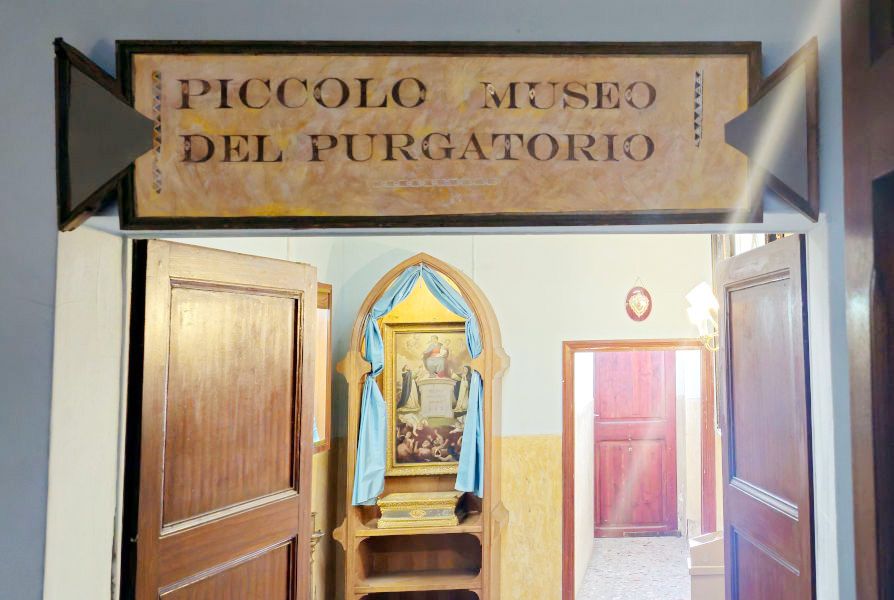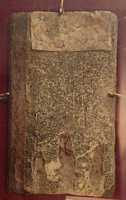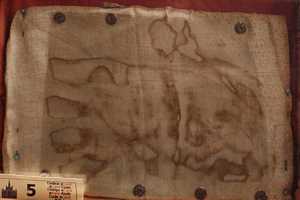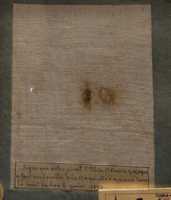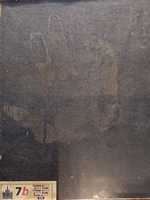Reading time: 7 min.
In the heart of Rome, on Lungotevere Prati, lies one of Christianity’s most unique places, the Museum of the Souls in Purgatory, housed in the Church of the Sacred Heart of Suffrage. This tiny museum, one of a kind, collects objects marked by mysterious traces — burns, imprints, signs — which, according to tradition, were left by purgatorial souls to ask for prayers and suffrages. We are faced with the oldest and most decisive question; what happens after death? And again, can we do something for those who have gone before us?
A museum born from fire
In 1893, the French missionary Father Victor Jouët founded the Association of the Sacred Heart of Suffrage for the Souls in Purgatory, with the aim of spreading devotion to the Sacred Heart of Jesus and the Madonna. After establishing a first oratory in Via dei Cosmati, he opened a second on a plot of land along the Lungotevere, where he planned to erect a church.
In 1897, as work progressed, a fire broke out in a small chapel within the complex. As the flames were extinguished, Father Jouët noticed the image of a suffering face on the altar wall among the marks left by the fire. For the religious man, that vision was a providential sign, a call from the depths of Purgatory from a soul imploring prayer.
He decided to preserve that image and collect other tangible proofs, convinced that God could, in exceptional cases, allow souls to manifest themselves to remind us of the duty of charity towards the deceased. His intention was not to fuel superstition, but to strengthen faith in the Catholic dogma of Purgatory and promote the practice of suffrage.
Thus, the small museum was born, inaugurated in the early 20th century and still open to visitors. The few exhibited objects are all authenticated by documents. It is not a spectacular exhibit, but each relic seems to silently cry out, “Pray for us!”
The tangible signs of the afterlife
The museum houses burnt imprints on fabrics, books, garments, and wooden tablets. Each exhibit tells a story of silent supplication. Among the pieces is the imprint of a burnt hand on the apron of Maria Herendorps, a lay Sister of the Benedictine order in Vinnenberg, belonging to Sister Klara Schoelers, who had died 59 years earlier. There is the imprint of a burnt hand in the wood, on this fragment of wood from the desk that belonged to the Servant of God Mother Isabella Fornari, who was prioress of the Poor Clares in Todi. There is the imprint of a burnt hand on a copy of the book, “The Imitation of Christ,” belonging to Margherita Demmerle of Ellenghen (Metz, France) and others.
These signs, subjected over the years to ecclesiastical verifications, are presented as testimonies of faith, invitations to reflect on the mystery of death and the communion of saints that binds the living and the deceased.
The theology of Purgatory
From the earliest centuries, the Church has believed that after death there is a purification for those who die in a state of grace, but not yet completely free from sin. The Catechism of the Catholic Church defines it as “the final purification of the elect, which is entirely different from the punishment of the damned” (CCC 1031).
Saint Thomas Aquinas warns us that “the least pain of Purgatory surpasses the greatest pain on earth.” Many other saints confirm this view: Saint Bonaventure, Saint Robert Bellarmine, Saint Catherine of Genoa, Saint Faustina Kowalska, Saint Pio of Pietrelcina.
The explanation is simple. On earth, sufferings are meritorious if we consciously unite them with those of the Saviour and cannot exceed a certain level without the soul separating from the body. In Purgatory, sufferings are no longer meritorious, and there is no limit of the body. Precisely for this reason, the only way to alleviate such pains is through the prayers and suffrages of those on earth.
The Church teaches that the living can help souls through prayer — especially with the offering of Holy Mass — works of charity, and indulgences. This doctrine expresses the profound unity of the Mystical Body of Christ, where members support each other even beyond the boundaries of death.
Purgatory, however, is a place of hope, not despair. Souls know they are saved and can reach Heaven after the expiation that did not fully occur on earth. Only saints enter Heaven!
An invitation to spiritual charity
The museum does not aim to be a place of fear or sensationalism, but a call to spiritual charity towards the deceased. In contemporary culture, which often removes or trivialises the thought of death, this space invites us to rediscover an essential dimension of faith; the memory of the dead and spiritual responsibility towards them.
Praying for the deceased is an act of love that spans generations. It is to recognise that death does not break the bonds of love, but transfigures them. Every Holy Mass celebrated, every rosary recited, every good work offered for a soul in Purgatory is a gesture of solidarity that anticipates the perfect communion of Heaven.
Father Jouët understood that suffrage risked being forgotten in modern society, increasingly distracted by the present and unable to contemplate eternity. His museum aimed to be a reminder. The souls of our loved ones continue to exist, to hope, to desire the fullness of divine love.
Discernment and tradition
The Church has always encouraged discernment regarding extraordinary phenomena. Not everything that appears supernatural truly is, and authentic faith does not need prodigious signs to be solid. However, Christian tradition is rich in testimonies of saints and mystics who spoke of encounters with souls in Purgatory, from Saint Perpetua to Saint Catherine of Genoa, from Saint John Bosco to Padre Pio.
The museum fits into this tradition with humility, presenting the exhibits, not as dogmas of faith, but as testimonies that invite reflection. Their supernatural authenticity can be debated, but their spiritual value remains, to remind us that earthly life is a passage, that death is not the end, and that we are called to live in communion with the entire Church — the triumphant in heaven, the militant on earth, and the suffering in Purgatory.
Purgatorial souls can no longer merit for themselves, but they can benefit from our prayers. Saint Francis de Sales said that “charity does not stop at the gates of the tomb.” And Saint Monica said to Saint Augustine, “I ask you but one thing, to remember me at the altar of the Lord.”
Every time we celebrate a Mass of suffrage or recite an “eternal rest,” we participate in a silent miracle of eternal solidarity; the flames stop, and purification mysteriously advances.
A visit that transforms
Visiting this museum means confronting the ultimate questions of existence: what is there after death? How can I prepare? What does it mean to love someone even beyond the grave? In an era that avoids talking about death, this space offers an opportunity for serious and profound reflection.
The Church of the Sacred Heart of Suffrage, with its neo-Gothic architecture standing out against the Roman sky, thus becomes a bridge between earth and heaven, between time and eternity. The museum inside is but a small room, yet it carries a universal message; Christian love knows no bounds, not even that of death.
The Museum of the Souls in Purgatory remains a unique place where faith and mystery meet in a surprising way. Whether these phenomena are accepted as authentic supernatural manifestations or not, their spiritual meaning is clear. We are called to remember our deceased, to pray for them, to live in a way that prepares us for the encounter with God.
In a world that tries to erase death from collective consciousness, this small Roman museum whispers an ancient and ever-relevant truth. Life is short, eternity is long, and love — if true — lasts forever. The souls in Purgatory only ask to be remembered, loved, and accompanied with prayer towards the eternal light of God.
Image gallery

